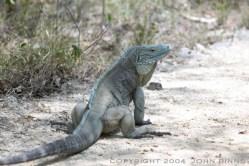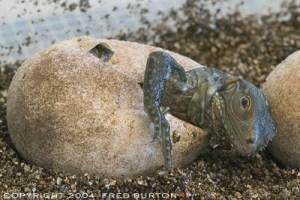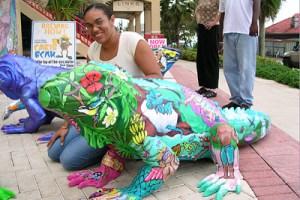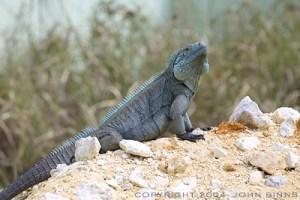Blue Iguanas Are Recovering from Near Extinction Because People Care
In 2003, when the bus driver volunteered to detour from her regular route to drop us at the gate of the Queen Elizabeth II Botanic Park on Grand Cayman island’s east end, she exhibited the typical concern that Grand Cayman residents have for visitors and gave us advice on who to call to get a ride back to Georgetown.

Photo by John Binns
A large lazy Blue Iguana stopped us at the guard station. The station attendant introduced us to the iguana, obviously proud of the four-foot long blue dragon, and encouraged us to visit the captive breeding program. We had come to see the plants, but the Iguanas were clearly the star attraction.
We learned that once thousands of Blue Iguanas had lived on the island, basking on the beaches and sleeping in the woods. By 2002, the year before we came, hunting, habitat destruction, and introduced predators eroded the population down to less than 25 individuals.

Photo by Fred Burton
At the Botanic Park, breeding Iguanas lived in a monitored area surrounded by a low wall. The wall protected eggs and hatchlings from a snake, the only native predator, and from non-native rats, cats, and dogs. Outside the wall, the introduced predators as well as automobiles threatened adults as well as immature Iguanas.
Wildlife biologists had designed an Iguana Recovery Program with a goal of 1000 individuals. In 2011, an estimated 650 iguanas were living in the wild. The Recovery Program has probably reached its goal of 1000 individuals by now.

Photo by Fred Burton
Why was the program so successful? I think it is because of the pride and concern the people of Grand Cayman had for their Blue Iguanas. When the news spread that the species was almost extinct, everyone became concerned. My wife and daughter returned to Cayman in 2004, and found large brightly decorated iguana figures in conspicuous places here and there about town.
Long-term survival of the Blue Iguana is uncertain. Grand Cayman is not too large (76 square miles), and development is occurring on the island’s east end where the recovering Iguanas live. Some reserved areas have been set aside, but they are small. As the human population in the area grows, the number of cats, dogs, and automobiles will increase. One dark possibility is that Iguana numbers will again begin to sink, and developers will decide to send the surviving animals to a zoo and replace their refuges with houses.
Several non-profit organization are working to preserve more natural habitat for the Iguana. Please visit the National Trust for the Cayman Islands and the International Reptile Conservation Foundation, to see what you might do to support their efforts. The Blue Iguana is not yet safe.

Photo by John Binns
Learn more about the Iguanas at the Blue Iguana Recovery Program website.

